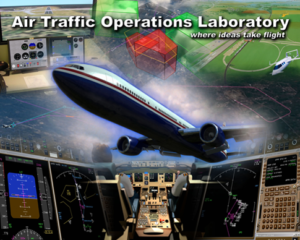
The Air Traffic Operations Lab (ATOL) provides air traffic management (ATM) concept and procedure simulation capability. This capability, referred to as the Airspace and Traffic Operations Simulation (ATOS), is made compatible with current aviation system architectures and the evolving National Airspace System (NAS) infrastructure.
The ATOL hosts over 500 computing platforms (12 of which are single-pilot stations). Each aircraft is referred to as an ASTOR, or Aircraft Simulation for Traffic Operations Research. This arrangement allows active airline pilot test subjects to fly new concepts in high-density traffic scenarios. Three en-route and two terminal Air Traffic Control (ATC) stations are incorporated in the ATOL and give live controllers the capability to communicate with the pilots via voice and data link communication systems.

The ATOL can be connected to air traffic and flight simulations at other facilities via the Aviation Sim Net to implement more comprehensive simulations. The ASTOR arrangements allow researchers to simulate a variety of airspace and air traffic situations while also evaluating advanced decision aids and airborne communication, navigation, and surveillance (CNS) systems. The ATOS also provides the capability to evaluate crew workload and performance and can be linked up with ATM and flight simulation labs across the country. The simulation environment fostered by the ATOL can be used to conduct: operational feasibility assessments, system-level requirements definition, airborne and ground-based CNS technology requirements determination, and human-centered design and assessment of ATM concepts and flight deck systems.
